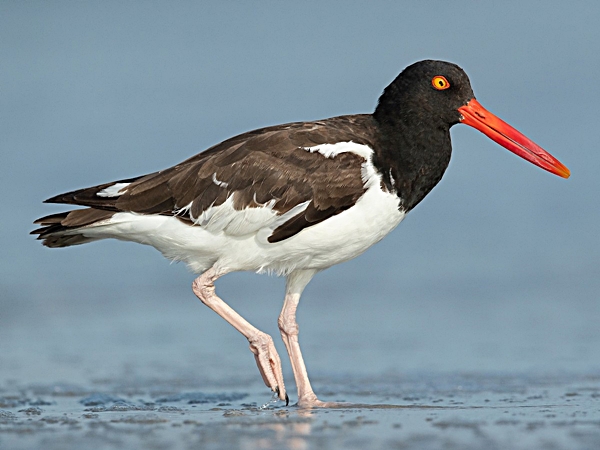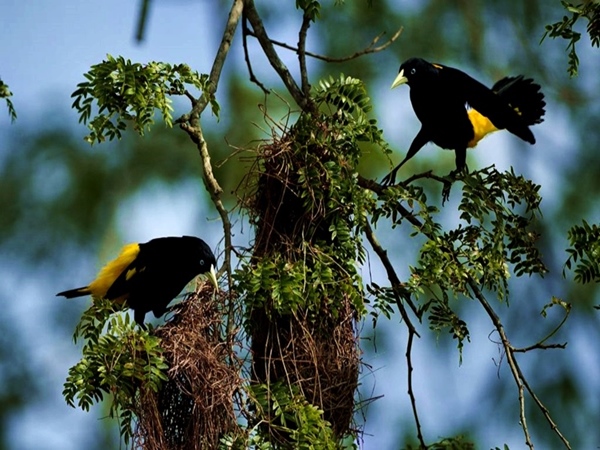Magnificent Frigatebird

The giant frigatebird is one of my favorite Birds of Bahia de Caraquez, also known as the magnificent frigatebird, is a large seabird found in many tropical and subtropical regions around the world, including Ecuador. The species is characterized by its massive wingspan, which can reach up to 7.5 feet (2.3 meters), and its long, forked tail. The male giant frigatebird is particularly notable for its striking appearance during breeding season, when its throat pouch becomes engorged and bright red. This pouch is used in courtship displays to attract females.
In Ecuador, giant frigatebirds are commonly seen along the Pacific coast and the Galápagos Islands, where they are known to nest and roost in large colonies. The birds are skilled flyers and spend much of their time soaring over the ocean, using their long wings to catch updrafts and remain aloft for hours at a time. They are also adept at stealing food from other seabirds, including boobies and terns, by chasing them in midair and forcing them to regurgitate their catch.
Despite their impressive size and aerial abilities, giant frigatebirds are considered to be a species of conservation concern in Ecuador and other parts of their range. Habitat loss, human disturbance, and hunting for their feathers and meat have all contributed to population declines in some areas. However, efforts are underway to protect the birds and their habitats through measures such as habitat restoration, ecotourism, and community-based conservation initiatives.
The most colorful of the Birds of Bahia de Caraquez: Motmot

The motmot is a unique and colorful bird found in many parts of Central and South America, including along the coast of Ecuador. The bird is named for its distinctive tail, which has two long, racket-shaped feathers that trail behind it as it flies. The tail feathers are used in courtship displays and are also believed to play a role in communication with other motmots.
In Ecuador, the motmot is found in a variety of habitats, including tropical forests, mangroves, and coastal scrub. The bird is known for its vibrant plumage, which includes shades of green, blue, and bronze. It has a distinctive eye mask and a slightly curved bill that is adapted for catching insects and small prey.
Motmots are primarily insectivorous, feeding on a variety of insects, spiders, and other small invertebrates. They are also known to eat small lizards and fruit. The birds are active during the day and can often be seen perching on low branches or along the edges of forest clearings.
Burrowing Owl
The Burrowing Owl is a small, ground-dwelling bird found throughout North and South America, including in parts of Ecuador. The bird is named for its habit of nesting in underground burrows, which it either digs itself or takes over from other animals such as prairie dogs or ground squirrels. Burrowing owls are also known for their large, expressive eyes, which are adapted for low-light hunting and help give them a distinctive appearance.

Burrowing owls are active during the day and can often be seen perching on the entrance to their burrow or flying low over nearby fields and grasslands in search of prey. They are opportunistic hunters and will feed on a variety of small animals, including insects, rodents, reptiles, and even small birds.
American Oystercatcher

The American Oystercatcher is also found along the coast of Ecuador, particularly in the Galapagos Islands and the western coast of the country. They play an important role in maintaining the health of coastal ecosystems by controlling the population of bivalves and other invertebrates.
The Iconic Brown Pelican – A Bird of Bahia de Caraquez
Did you know that the Brown Pelican is the only pelican species that dives headfirst into the water to catch its prey? Not only is it a skilled fisherman, but it also has a unique look with its long bill and large throat pouch that it uses to scoop up fish.
But here’s the funny part: the Brown Pelican has been known to accidentally catch more than just fish in its pouch. It’s not uncommon for them to accidentally scoop up a seagull or two in their attempts to catch a meal. And if you thought that was embarrassing enough, sometimes they even accidentally swallow their catch whole, only to realize too late that it’s not a fish!

So if you’re ever feeling down about making a silly mistake, just remember the Brown Pelican and how even skilled hunters can have an off day. And who knows, maybe one day you’ll accidentally catch a seagull too! (Just kidding, please don’t try to catch seagulls.)
Yellow Rumped Cacique, one of the many Birds of Bahia de Caraquez
The Yellow-rumped Cacique (Cacicus cela) is a medium-sized bird that inhabits the tropical regions of Ecuador and Bahia de Caraquez. Known for its striking yellow rump and lower back feathers, this bird belongs to the blackbird family and is an important member of the local ecosystems.

In Ecuador, the Yellow-rumped Cacique is found in various habitats, such as forests, woodlands, and mangroves. It is typically seen in small groups and is recognized by its loud and melodious calls. In Bahia de Caraquez, this bird inhabits the edges of forests and mangrove swamps and is particularly active during the breeding season. Male Yellow-rumped Caciques perform intricate displays to attract females, making them a fascinating sight to behold.
Saffron Finch Bird, the yellow Bird of Bahia de Caraquez
The Saffron Finch (Sicalis flaveola) is a small, brightly colored bird found in Ecuador, as well as other parts of South America. They inhabit a variety of regions, including the Andean highlands, coastal regions, and urban areas. Their striking yellow plumage, black wings, and white markings make them easily recognizable. Saffron Finches are highly social birds and often seen in pairs or small flocks. They feed on seeds, insects, and fruits and are known for their adaptability to living in urban areas.

Bahia de Caraquez offers a unique and unforgettable birdwatching experience. From the iconic Brown Pelican to colorful Yellow-rumped Caciques, and a variety of shorebirds, seabirds, and forest birds, the region is a paradise for birdwatchers. Plan your visit today and discover the incredible birdlife of this warm beach town.
Pallid Dove

The Pallid Dove, a plain medium-sized dove, is mostly found in western Ecuador but can also be seen in western Colombia and extreme northwestern Peru. It can be easily confused with the White-tipped Dove, which also occurs in the same range. However, the Pallid Dove can be distinguished by its notably darker and warmer brown upperparts that contrast with its whitish underparts. This ground-dwelling bird can often be seen walking on roads or trails or quickly flying across them. Although it is fairly common within its limited range, birdwatchers must be careful to differentiate it from the equally common White-tipped Dove. Listen for its low-pitched, single “hoo” call.
Great-Tailed Grackle
The Great-tailed Grackle, found in Ecuador, is a striking bird known for its long, keel-shaped tail feathers. With glossy black plumage and iridescent blue and green hues, males have a yellow eye while females have a brown eye. These adaptable birds inhabit various habitats, including coastal areas, wetlands, and urban settings. They feed on insects, fruits, grains, and small vertebrates, forming large flocks and displaying aerial acrobatics.



